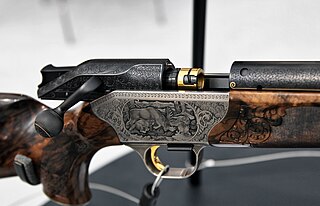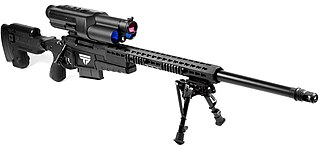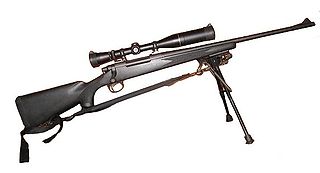 W
WBlaser Jagdwaffen GmbH is a German firearms manufacturer of high-end shotguns and rifles both for the hunting and tactical market. It was founded in 1957 by Horst Blaser, developing the drilling Blaser Diplomat. In September 2008, Blaser established a headquarters in San Antonio, Texas.
 W
WThe Blaser R93 is a German straight-pull action precision rifle offered in a multitude of calibers and barrel lengths. Designed by Blasers' designer Mr. Meinhard Zeh in 1993, it had a number of features rare on modern hunting rifles, including a manual cocking system and a proprietary Blaser saddle scope mount for mounting the optic directly to the quick-change barrel
 W
WThe Colt-Burgess rifle, also known as the 1883 Burgess rifle or simply the Burgess rifle, is a lever-action repeating rifle produced by Colt's Patent Firearms Manufacturing Company between 1883 and 1885. The Burgess rifle was Colt's only entrance into the lever-action rifle market, produced to compete with Winchester Repeating Arms Company's line of popular rifles. The 1883 Burgess rifle was designed and patented by Andrew Burgess, an American firearms designer and photographer, who sold the design to Colt.
 W
WA combination gun is a firearm that comprises at least one rifled barrel and one smoothbore barrel, that is typically used with shot or some types of shotgun slug. Most have been break-action guns, although there have been other designs as well. Combination guns using one rifled and one smoothbore barrel usually are in an over and under configuration. Side-by-side versions are referred to as cape guns. A drilling is a combination gun that has three barrels. A vierling has four barrels. Combination guns generally use rimmed cartridges, as rimless cartridges are more difficult to extract from a break-action weapon.
 W
WThe double rifle, also known as the double-barreled rifle, is a rifle with two barrels mounted parallel to each other. Synonymous with big game hunting in Africa and Asia, the double rifle is a purely sporting weapon with no military heritage.
 W
WThe Farquharson Rifle is a single-shot hammerless falling-block action rifle designed and patented by John Farquharson, of Daldhu, Scotland in 1872. George Gibbs, a gun maker in Bristol, became a co-owner of the Farquharson patent in 1875 and was the sole maker of Farquharson rifles until the patent expired. Fewer than 1,000 Gibbs-Farquharson rifles were made, the last one being delivered in 1910.
 W
WThe Hawken rifle is a muzzle-loading rifle that was widely used on the prairies and in the Rocky Mountains of the United States during the early frontier days. Developed in the 1820s, it became synonymous with the "plains rifle", the buffalo gun, and the fur trapper's gun. It was displaced after the Civil War by breechloaders and lever-action rifles.
 W
WThe long rifle, also known as longrifle, Kentucky rifle, Pennsylvania rifle, or American longrifle, was one of the first commonly used rifles for hunting and warfare. It is characterized by an unusually long barrel, a development in American rifles that was uncommon in European rifles of the same period.
 W
WThe Martini–Henry is a breech-loading single-shot rifle with a lever action that was used by the British Army. It first entered service in 1871, eventually replacing the Snider–Enfield, a muzzle-loader converted to the cartridge system. Martini–Henry variants were used throughout the British Empire for 47 years. It combined the dropping-block action first developed by Henry O. Peabody and improved by the Swiss designer Friedrich von Martini, combined with the polygonal rifling designed by Scotsman Alexander Henry.
 W
WThe musket Modèle 1777, and later Modèle 1777 corrigé en l'an IX was one of the most widespread weapons on the European continent.
 W
WPrecision guided firearms (PGFs) are long-range rifle systems designed to improve the accuracy of shooting at targets at extended ranges through target tracking, heads-up display, and advanced fire control. Inspired by missile lock-on and fighter jet technology, the application of PGF technology to small arms mitigates multiple sources of marksman error including mis-aim, trigger jerk and shot setup miscalculation. PGFs can significantly increase first shot success probability (FSSP) out to extreme ranges of 1,200 yards or more.
 W
WThe Remington M1867 was a rolling-block rifle, the first rifle using metallic cartridges to be adopted by the Norwegian and Swedish armies. Nominally it had a caliber of 4 decimal lines, but the actual caliber was 3.88 Norwegian decimal lines or 4.1 Swedish decimal lines (12.17 mm), and it fired a rimfire round with a 12.615 mm lead bullet. The 12.17 mm caliber was chosen because the Swedish army had approximately 30,000 new muzzle-loading M1860 and breech-loading M1864 rifles in 12.17 mm caliber in stock, rifles that were suitable for conversion to M1867 rolling-block rifles. With the exception of the first 10,000 rifles and 20,000 actions, which were made by Remington in the US, all Remington M1867 rifles and carbines were made under license in Norway and Sweden, by Kongsberg Vaapenfabrik in Norway, and by Husqvarna Vapenfabriks Aktiebolag and Carl Gustafs stads Gevärsfaktori in Sweden with the two Swedish manufacturers producing about 80% of the weapons.
 W
WThe Remington Model 700 is a series of bolt-action centerfire rifles manufactured by Remington Arms since 1962. It is a development of the Remington 721 and 722 series of rifles, which were introduced in 1948. The M24 and M40 military sniper rifles, used by the US Army and Marine Corps, respectively, are both based on the Model 700 design.
 W
WSharps rifles are a series of large-bore, single-shot, falling-block, breech-loading rifles, beginning with a design by Christian Sharps in 1848, and ceasing production in 1881. They were renowned for long-range accuracy. By 1874 the rifle was available in a variety of calibers, and it was one of the few designs successfully to be adapted to metallic cartridge use. The Sharps rifles became icons of the American Old West due to their appearances in many Western-genre films and books. Perhaps as a result, several rifle companies offer reproductions of the Sharps rifle.
 W
WThe Sharps-Borchardt Model 1878 is a single-shot hammerless falling-block action rifle designed by Hugo Borchardt and made by the Sharps Rifle Manufacturing Company. It closely resembles older Sharps Rifles but has a firing mechanism that uses a hammerless striker rather than a hammer and firing pin like the old Sharps Rifle. This hammerless dropping-block breech-loader was based on a patent granted to Hugo Borchardt in 1877. It was the last of the Sharps single-shot rifles, and the Borchardt did not sell very well. According to company records 22,500 rifles were made in all models from 1877 until the Sharps Rifle Co. closed down in 1881. Although it was designed for the huge black powder "buffalo" cartridges of the day, it came too late, at the very end of the great bison slaughter.
 W
WSingle-shot firearms are firearms that hold only a single round of ammunition, and must be reloaded manually after every shot. The history of firearms began with single-shot designs, then multi-barreled designs appeared, and eventually many centuries passed before multi-shot repeater designs became commonplace.
 W
WThe Snipex Rhino Hunter is a civilian version of the Snipex M rifle chambered for .50 BMG, developed by the Ukrainian company XADO-Holding Ltd.
 W
WThe Tikka T3 is a series of bolt-action rifles manufactured by Sako under their Tikka brand in Riihimäki, Finland since 2003. The series is available in a wide variety of different sight, calibre and stock configurations as well as several barrel lengths. The rifle series was developed by Sako product development team led by Kari Kuparinen.
 W
WThe Winchester Model 1892 was a lever-action repeating rifle designed by John Browning as a smaller, lighter version of his large-frame Model 1886, and which replaced the Model 1873 as the company's lever-action for pistol-caliber rounds such as the .44-40.